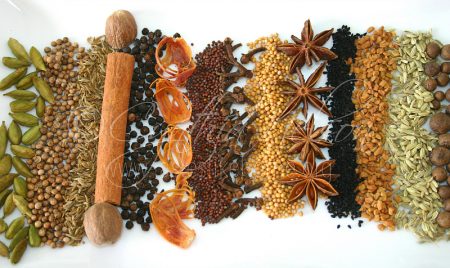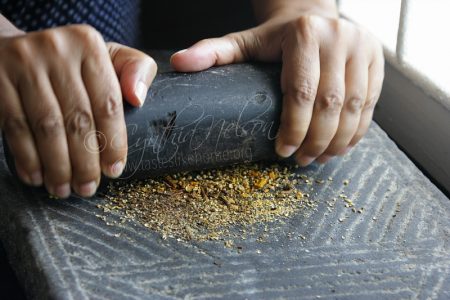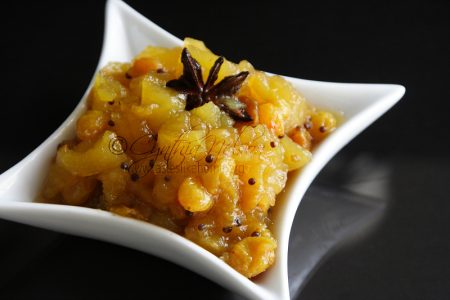Hi Everyone, What’s Cooking is a series in which I answer questions and share advice about food and cooking that you may have but are too shy to ask.
 Hot from the pan, the spices are tipped on to the large grinding stone (sill). Light wisps of smoke curl into the air. The long, heavy, oblong-shaped grinding stone (lorha) is picked up and pressed against the spices, crushing them. Crisp from the heat, the spices crack and crunch under the weight of the lorha as they simultaneously release their collective, captivating aroma. Back and forth the hands work the stone until the spices are ground to a fine powder. This is one of the many ways spices are prepared for cooking.
Hot from the pan, the spices are tipped on to the large grinding stone (sill). Light wisps of smoke curl into the air. The long, heavy, oblong-shaped grinding stone (lorha) is picked up and pressed against the spices, crushing them. Crisp from the heat, the spices crack and crunch under the weight of the lorha as they simultaneously release their collective, captivating aroma. Back and forth the hands work the stone until the spices are ground to a fine powder. This is one of the many ways spices are prepared for cooking.
Well known and valued for their fragrance and flavour, spices offer unique character to a dish – sweet or savoury. Even though our cuisine is rich with the use of a wide variety of spices, there are many among us who are unsure how to use this group of flavour ingredients. In this edition of What’s Cooking, I’ll discuss buying and storing spices, the various ways to prepare spices for cooking and the general application of spices when cooking.
What are spices?

Spices are the dried seeds, buds, fruit, flower parts, bark, roots, and leaves of plants.
While there are some spices that are available fresh and dried, they are not interchangeable in flavour when applied to food; for example, turmeric and ginger. Dried ground ginger has a warm and spicy bite but it is not as strongly flavoured as fresh ginger. Ginger in ground form is generally added when mixed in with other ingredients for baking and making spice rubs. Dried turmeric when ground to a powder is not as vibrant in colour as when in its fresh form, more importantly, if too much dried turmeric is added to a dish (beyond what is stipulated in a recipe), the finished dish can end up with bitter notes.
Buying and storing spices
Whole and ground (as in a powder) are the two forms in which spices are sold. Wherever possible, it is highly recommended that you buy whole spices, simply because they last longer. However, there are sellers that grind their own spices to sell, and they do so fresh on the spot or on a regular basis – this is the ideal option if you are buying ground spices. Ground spices lose their flavour and aroma quickly, so be prepared to use them soon after purchasing.

Another factor to consider when buying spices is to let the quantities you purchase be reflective of your use. For example, don’t buy a pound of star anise if you know you only use it 2 or 3 times a year when making a specific dish. On the other hand, if you find that cinnamon, allspice and mustard seeds are ingredients you use regularly, stock enough to last you for at least 2 – 3 months.
Here’s the thing, if you live in a place where there is ready access to spices, there is no need to overstock. Buy a certain quantity based on your use.
Finally, the main thing to know about buying spices – whole or ground – is to purchase from a seller/shop where there is rapid turnover. In other words, buy your spices from a place or person that constantly replenishes their stock due to regular, frequent sales.
So you’ve come home with your stock of spices, where and how do you store them? Whether whole or ground, store your spices in airtight containers in cool, dark cupboards or drawers. Light, heat and moisture lessen the quality of spices; therefore, if you store your spices close to the stovetop or oven, move them, especially if they are in glass jars, bottles.
If you store your spices in wooden boxes, or storage items made of metal or China or opaque material, it is not necessary to place them somewhere dark, nevertheless, you would want store them somewhere cool and away from kitchen heat.
Depending on where you live, and your home, there are not a lot of cool places in this tropical environment, so to extend the shelf life of your spices, you can consider storing them in their airtight containers in the refrigerator, particularly the ground spices.
Stored properly, whole spices will last for 6 months and longer, ground spices 3 to 6 months. To check for the freshness of ground spices, open the storage container and sniff, the aroma should be evident from the time the top is open.
Prepping spices
The dish you are making and the recipe you are using will determine how the spices are to be prepared for addition to the dish. Whole, cracked, crushed, or ground are the various ways that spices are prepared for use. Depending on the recipe, some spices are added raw, whether whole, cracked or crushed, while others require roasting before being ground – coarsely or to a fine powder.
Roasting & grinding

Roasting warms the spices awakening their essential oils that provide optimum flavour and aroma. Spices can be dry or wet roasted.
Dry roasted spices are always ground very fine to form part of a spice blend, paste or marinade. The spices are added to a lightly heated dry pan, (sometimes a cold dry pan) over medium-low heat and tossed, moved around, shaken for several minutes until they are heated through and fragrant. It is very easy to determine when the spices are done roasting – their aroma fills the air, and the spices start to pop. It is important to not stray too far from the stove when roasting spices as they heat up quickly and can burn easily. Burnt spices equal bitter flavour in your food.
To dry roast spices, always use a flat pan so that the spices can be spread out evenly. Using a pan with a handle makes easy work of being able to shake and toss the spices intermittently. Grind the spices soon after they are finish roasting and use immediately. If you are roasting and grinding for storage, when you are finish grinding, let the spices cool a little before tightly putting a lid on the jar.
If the recipe you are following says to let the spices cool after roasting, remove the spices from the pan and let cool on a plate, the residual heat from the pan will continue to roast the spices and may even scorch then, altering their flavours.
To grind spices, use a lorha and sil/sil batta, mortar and pestle or a spice grinder. Don’t go out and look specifically for a spice grinder though, unless you want to. A coffee grinder does an excellent job of grinding spices. If you are going to use a coffee grinder, get one separate from the one you use to grind your coffee.
Wet roasting is when spices are cooked (fried) in hot oil; the purpose here is to season/flavour the oil. The flavoured oil is used to cook the dish or to add the final seasoning to a dish. For example, every time we fry sliced garlic and whole jeera/cumin, mustard seeds and add the mixture to cooked dhal, we are wet roasting the spices to flavour and add the final seasoning to the dish. Look out for tomorrow’s recipe in In Good Taste and you will see how the spices are wet roasted in oil to season the chutney.
Break, crack & crush
While some spices are added whole to dishes as they cook, breaking, cracking or crushing them will release a little more flavour. Each recipe determines how the spices are to be added or administered. Spices such as cardamom, allspice, black peppercorns and juniper berries benefit from being cracked or crushed, while cinnamon sticks, whole star anise and dried chili can be broken into pieces before being added to the pot.
Cooking with spices
There are no hard and fast rules about which spice to use with which ingredients, what we have are many traditional combinations that we use in our everyday cooking. While cuisines all over the world use spices, it is the application of the spices that distinguishes one cuisine from another. Spices also offer us an opportunity, on an individual level, to personalize our cooking.
The state of the spices – whole, cracked, crushed, broken or ground – added to a dish determines the degree of flavour to be imparted. The time the spices are added – beginning, during, finishing – contributes to the flavour and aroma of a dish.
The recipe you are using will always guide you as to how and when to add spices. And here is one major thing you need to know:
Some spices are added for their taste while others are added for their aroma. Spices added at the beginning of cooking are for flavour. Spices added at the end of cooking are for aroma.
- Depending on the dish and cooking time:
- Whole spices impart light flavour
- Whole spices cracked, crushed or broken impart moderate to medium flavour
- Ground spices impart full-bodied flavour
Use the guide above as you introduce people to different spices and flavours. Whenever I want to introduce someone to curry, fish curry in particular, I always make it in the style of Kerala’s Fish Molee – fish curry cooked with coconut milk and whole spices. The flavour is light, clean, and easy on the palette.
Cynthia









